The Olderfleet Building
This handsome building, once stretching all the way to Flinders Lane, was the central hub for Victoria’s wool and agriculture industry.
Constructed in 1890 for businessperson Patrick McCaughan, the Olderfleet was designed by William Pitt, one of the most outstanding architects of the late 1800s, responsible for many elaborate High Victorian commercial buildings at the time.
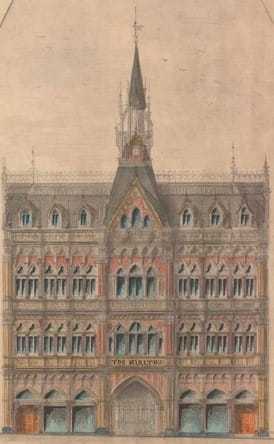
Image: Sketch of Collins Street elevation of the Olderfleet building by William Pitt, May 1889
The Design
Pitt designed the building in the Venetian Gothic style, with a façade comprising three bays featuring a stunning Ruskinian encrusted façade with a striking central spire, a pinnacle Gothic Revival clock tower its crowning glory.
The Olderfleet building contributes to the striking Gothic streetscape of Collins Street, including the Rialto building and the Stock Exchange. The building was unique for its time as it focused on depth, rather than height. Of the three buildings, it contained the most modern offerings for its tenants, with around 30 offices on each floor, all of them connected to the telephone exchange. In fact, only minor changes were made to the original building in the hundred years that followed.
An 1890 report in the Argus described the recently completed Olderfleet:
‘Any ordinary passer-by in this locality will note the presence of a new building with an unusually handsome façade, and one of the first details observed will be the broad archway leading to the entrance-hall ... As regards the ornamental detail, there are foliated capitals, bosses, rosettes, spandrels, and other decorative devices in cement work, all harmonising well to suit the free style of the façade.’
The Olderfleet Clock quickly became an iconic fixture on Collins Street; the same Argus report waxed lyrical: ‘There are very pretty gables to this tower, which gives an exceedingly pleasant and appropriate finish to the building.’
Epicentre for Wool Trade
The sight and smell of wool defined Melbourne in the 1890s, with this global commodity bringing prosperity to the entire country as it was bought, sold and shipped around the world. With the Wool Exchange neighbouring the Olderfleet Building at 487 – 495 Collins Street (now the Winefield Building), and the Yarra River wharves a short walk away, the Olderfleet quickly became an epicentre for brokers and sellers conducting wool auctions and managing wool sales rooms.
Collins Street was a buzzing hub for important figures in the wool industry to socialise and network, with the Melbourne Woolbrokers Association residing in the Olderfleet Building in 1900.
It was only when a new wool exchange was constructed in King Street some fourteen years later that the number of wool brokers at Olderfleet began to decrease and a broader range of agricultural agents took their place.
Image: The New Zealand Loan and Mercantile Agency Company’s wool sales at the Olderfleet, 27 November 1902 Source: Australasian, 6 November 1902, p. 29
Its close proximity to the ports along the Yarra River and the Western Market attracted an eclectic mix of tenants in the early years of the Olderfleet building, including the Melbourne Harbour Trust, the Pastoralists’ Union, Sailor’s Home, the Victorian Shipwreck Relief Society and various professionals involved in the thriving agricultural trade.
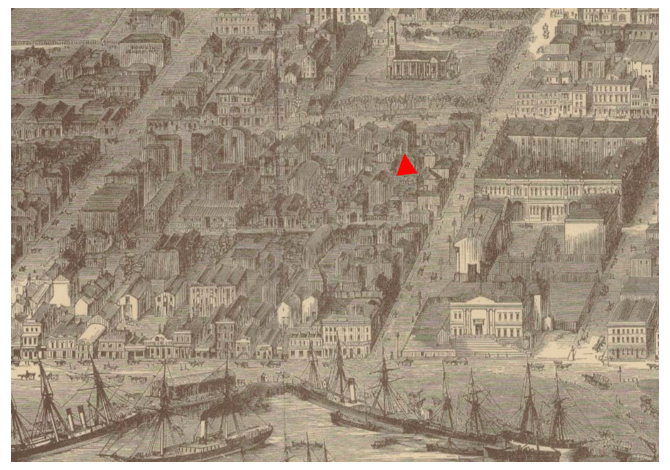
Image: Panoramic view of Melbourne showing detail of topography and buildings, 1871 by A C Cooke, published in the Illustrated Australian News Source: State Library of Victoria
Community Centre
Wool wasn’t the only thing that filled the walls of the Olderfleet Building in the 1890s. The Wool Room was also the gathering place for community meetings. Most notably, when the Reverend E S Hughes of the Christian Social Union delivered a compelling sermon to 80 people on 12 March, 1897, emphasising the need to integrate Christianity into commerce during Melbourne’s boom.
Post-War Tenants
Tenants of the twentieth century reflected the political and social climate of the time, with agencies relating to the war effort and post-war recovery. Tenants occupying the building included; the Department of Defence, Naval Control Service, Commonwealth Censorship Office, Department of Supply and Development, Department of Civil Aviation and the Liquid Fuel Board.
The Missing Clock
For 90 years, the Olderfleet Clock faithfully watched over Collins Street, its iconic presence taken for granted by those who lived and worked in the area. That is, until 1985 when, in the face of the site’s redevelopment, the clock went missing. Comically, the clock soon began writing to The Age, congratulating itself on “escaping the possible fate of ending up on a developer’s living room wall,” and advising readers, “I will not be returning.”
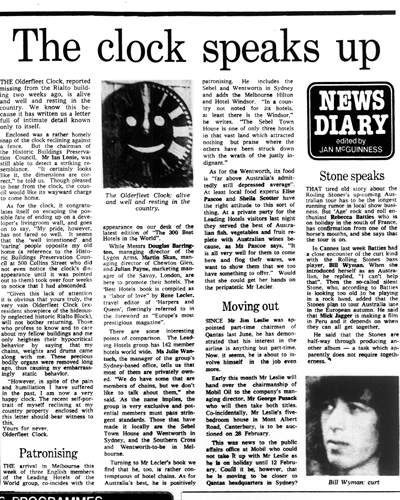
Becton, the site’s developer, beseeched the clock, also writing to The Age, “Please come back. The building won’t be the same without you.”
Following negotiations with the Historic Buildings Council, the Olderfleet building was beautifully restored in 1985, the Olderfleet Clock returned to its rightful place once more.
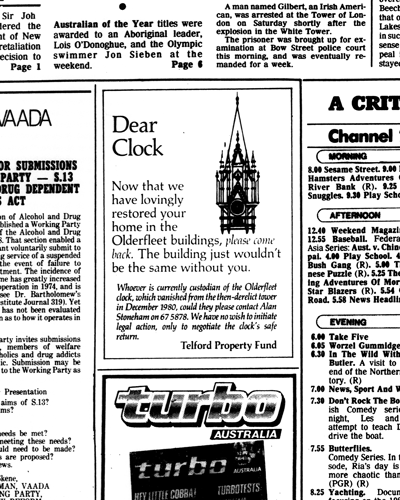
In a letter to The Age, titled ‘My life on the run’, the charismatic clock wrote to the developer one last time, offering its blessing to the Olderfleet building:
“My life on the run made me suspicious of every stranger, every knock on the door, and every idle construction worker…Good people of Melbourne, it is now obvious that certain developers can work in conjunction with the HBC and provide for both their own and the council’s interest. Nowhere is such a harmonious building more obvious than the Olderfleet complex in Collins Street.”
The Collins Street Defense Movement, 1970s
In post-war era in Melbourne, the character of the city was changing, with taller office towers constructed in the CBD, particularly in the western end of Collins Street due to growing demand for modern workplaces.
All three buildings were owned by Hammerson Group, who wanted to develop the whole site. A community-led campaign, which the National Trust spear headed, called the Collins Street Defence Movement came out against the demolition of the buildings. The initial focus was on the Olderfleet building, which eventually led to the retention of the front portions of all three buildings during the 1980s.
In 1978, the Trust published the Collins Street Report, a comprehensive survey of buildings of the street, with recommendations for height controls and setbacks. In the report, the Trust collectively calls the buildings ‘The Olderfleet Place buildings’. They were central to the report, used as the cover image for the publication.
The movement lead to the introduction of the first state heritage legislation, known as the Historic Buildings Act, which has been instrumental in upholding the significant history of Australia’s architectural movement.
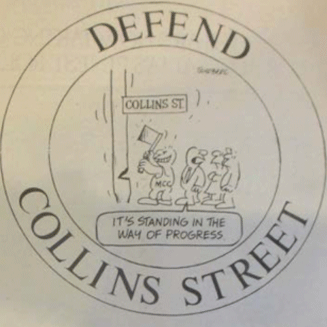
Image: Lovell Chen Endorsed Interpretation Strategy

